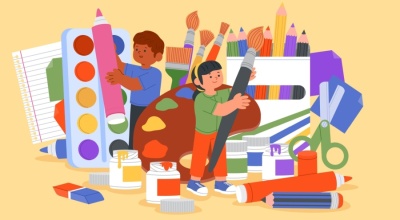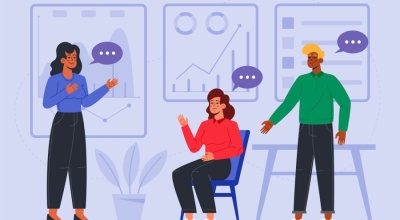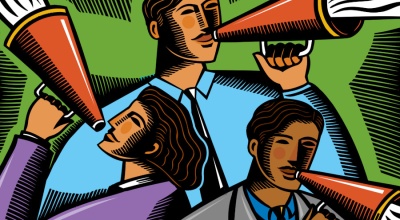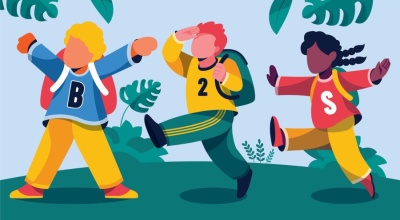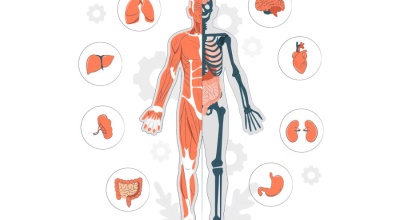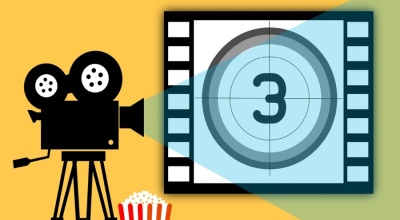Learn about Teaching for Change and how to access resources based on the concepts of racial equity, popular education, community organizing, and research on family engagement.
Teaching Resources
Teaching for Change provides teachers and parents with the tools to create schools where students learn to read, write, and change the world.
By drawing direct connections to real world issues, Teaching for Change encourages teachers and students to question and re-think the world inside and outside their classrooms, build a more equitable, multicultural society, and become active global citizens. Our professional development, publications, and parent organizing programs serve teachers, other school staff, and parents. Our main focus is national and we have dedicated programs in the Washington, D.C. metropolitan area.
Video: Building Stronger Schools with Parent Power
This story is one example of how we build stronger schools with parent power. Teaching for Change's approach to family engagement increases parents’ access to schools and broadens their roles as supporters, educators, advocates, decision-makers, and ambassadors. In claiming these roles, parents use their power collaboratively to transform schools.
Resistance 101: A Lesson on Social Justice Activists and Strategies
Anti-Bias Education
Articles, Recommended Books
Anti-bias curriculum is an approach to early childhood education that sets forth values-based principles and methodology in support of respecting and embracing differences and acting against bias and unfairness. The overarching goal is creating a climate of positive self and group identity development.
Black Lives Matter at School
Lessons, Articles, Recommended Books, Films, and more
Resources for teaching about the 13 principles of the Black Lives Matter movement during the Black Lives Matter at School Week of Action (the first week of February) and all year long.
Challenge Islamophobia
Lessons, Articles, Recommended Books, and more
Most teaching resources and teacher workshops about Islam and Muslims focus on increasing knowledge of religious texts, beliefs, and rituals rather than addressing the root causes of Islamophobia. Rather, the lessons teach all of us to rethink what we know about the history of Muslims in the U.S., including the fact that Islamophobia is rooted in a history of racism.
Civil Rights Teaching
Lessons, Articles, Recommended Books, Films, and more
The Civil Rights Movement is celebrated in our national narrative as a people’s struggle for social justice. However, the powerful stories of everyday people organizing and working together for social change are lost in the teaching of a few major heroes and dates. Our book Putting the Movement Back into Civil Rights Teaching and companion website emphasize the power of people through a diversity of stories, perspectives, essays, photographs, graphics, interviews, and interactive and interdisciplinary lessons.
Social Justice Books
Articles, Recommended Books, Book Reviews
Teaching for Change developed SocialJusticeBooks.org in 2017 to identify and promote the best multicultural and social justice children’s books, as well as articles and books for educators.
Teaching Central America
Lessons, Articles, Recommended Books, Films, Biographies, History, and more
More than four million Central Americans reside in the United States today, yet the lack of resources in most schools on Central American heritage make the rich history and literature of the region invisible. Our goal is to encourage and support teaching about Central America in K-12 schools so that students can learn about this region, which has many ties to the United States through foreign policy, immigration, commerce, and culture.
Teach the Beat: Go-Go
Lessons, Articles, Recommended Books, Films, History, Classroom Visits, and more
Teaching for Change is honored to work with D.C. area schools and the authors of The Beat! Go-Go Music from Washington, D.C. to develop lessons and share teaching ideas for infusing the history and music of go-go in middle and high school social studies, language arts, math, music, and/or D.C. history classes, and to bring renowned go-go performers into D.C. classrooms.
Zinn Education Project
Lessons, Articles, Recommended Books, Films, and more
The Zinn Education Project promotes and supports the teaching of people’s history in classrooms across the country. The Zinn Education Project (a collaboration between Rethinking Schools and Teaching for Change) introduces students to a more accurate, complex, and engaging understanding of history than what is found in traditional textbooks and curricula.
We Recommend
The anti-bias movement was born out of the multiculturalism movement. Some of the people involved in the multiculturalism movement felt that it did not do enough to address social problems in the education system.
Definition of anti-bias: opposing or prohibiting unfair discrimination against people based on race, religion, etc.: preventing or counteracting bias (as in hiring practices) merriam-webster.com/dictionary/antibias
Anti-bias education is an approach to teaching and learning designed to increase understanding of differences and their value to a respectful and civil society and to actively challenge bias, stereotyping and all forms of discrimination in schools and communities.
Multicultural curriculum taught basic facts about diverse cultures, often on specially designated culture days or holidays, rather than systematically infused into the entire curriculum. While this did increase students' superficial knowledge of other cultures, educators wanted students to know why they did not know about other cultures and why certain people of certain ethnicities and classes are less likely to be economically successful.
The goals of the anti-bias curriculum are to raise awareness of bias and to reduce bias. Anti-bias curriculum transgresses the boundaries by actively providing children with a solid understanding of social problems and issues while equipping them with strategies to combat bias and improve social conditions for all.
Cultural bias is the phenomenon of interpreting and judging phenomena by standards inherent to one's own culture. The phenomenon is a problem central to social and human sciences, such as economics, psychology, anthropology, and sociology. Some practitioners must develop methods and theories to compensate for or end cultural bias.
Some California preschools are getting children to participate in conversations about racial differences at an early age by introducing an anti-bias curriculum that teaches kids about diversity and inclusion. Against a backdrop of national divides over race, these educators use art projects and discussions to infuse a powerful message into the classroom. Special correspondent Cat Wise reports.
Types from Wikipedia
Example: Biased or Opinionated Sources - Wikipedia articles are required to present a neutral point of view. However, reliable sources are not required to be neutral, unbiased, or objective. Sometimes non-neutral sources are the best possible sources for supporting information about the different viewpoints held on a subject.
Types of biases
A statistic is biased if it is calculated in such a way that it is systematically different from the population parameter being estimated. The following lists some types of biases, which can overlap.
- Selection bias involves individuals being more likely to be selected for study than others, biasing the sample. This can also be termed Berksonian bias.
--Spectrum bias arises from evaluating diagnostic tests on biased patient samples, leading to an overestimate of the sensitivity and specificity of the test. - The bias of an estimator is the difference between an estimator's expected value and the true value of the parameter being estimated.
--Omitted-variable bias is the bias that appears in estimates of parameters in regression analysis when the assumed specification omits an independent variable that should be in the model. - In statistical hypothesis testing, a test is said to be unbiased if, for some alpha level (between 0 and 1), the probability the null is rejected is less than or equal to the alpha level for the entire parameter space defined by the null hypothesis, while the probability the null is rejected is greater than or equal to the alpha level for the entire parameter space defined by the alternative hypothesis.
- Detection bias occurs when a phenomenon is more likely to be observed for a particular set of study subjects. For instance, the syndemic involving obesity and diabetes may mean doctors are more likely to look for diabetes in obese patients than in thinner patients, leading to an inflation in diabetes among obese patients because of skewed detection efforts.
- In educational measurement, bias is defined as "Systematic errors in test content, test administration, and/or scoring procedures that can cause some test takers to get either lower or higher scores than their true ability would merit. The source of the bias is irrelevant to the trait the test is intended to measure."
- Funding bias may lead to the selection of outcomes, test samples, or test procedures that favor a study's financial sponsor.
- Reporting bias involves a skew in the availability of data, such that observations of a certain kind are more likely to be reported.
- Analytical bias arises due to the way that the results are evaluated.
- Exclusion bias arise due to the systematic exclusion of certain individuals from the study.
- Attrition bias arises due to a loss of participants e.g. loss to follow up during a study.
- Recall bias arises due to differences in the accuracy or completeness of participant recollections of past events. e.g. a patient cannot recall how many cigarettes they smoked last week exactly, leading to over-estimation or under-estimation.
- Observer bias arises when the researcher subconsciously influences the experiment due to cognitive bias where judgment may alter how an experiment is carried out / how results are recorded.
Partner with organizations, children’s museums, schools, and families across the country to promote access to children’s books centering underrepresented and oppressed groups.
- The Conscious Kid is an education, research and policy organization dedicated to reducing bias and promoting positive identity development in youth.
- American Indians in Children’s Literature
- ADL’s Education Department provides educational programs, training and resources for grades PreK-12 and college/university settings. Our anti-bias and bullying prevention programs assist educators and students in understanding and challenging bias and building ally behaviors. Our work in confronting anti-Semitism empowers young people with constructive responses to combat anti-Semitism. We also have programs and resources to help students explore and critically reflect on the lessons of the Holocaust.
- The National Association for the Education of Young Children (NAEYC) is a professional membership organization that works to promote high-quality early learning for all young children, birth through age 8, by connecting early childhood practice, policy, and research. We advance a diverse, dynamic early childhood profession and support all who care for, educate, and work on behalf of young children. The association comprises nearly 60,000 individual members of the early childhood community and more than 50 Affiliates, all committed to delivering on the promise of high-quality early learning. Together, we work to achieve a collective vision: that all young children thrive and learn in a society dedicated to ensuring they reach their full potential.
Public Downloads
All items are free to view, share, and download.
Public Downloads - Español (Spanish)
When available, we provide all our content with a Spanish version in our public download section. You can find additional material from sources listed in all our articles.
Download Activities About Culture
Download Civil Rights, Activities, Information, and Resources
Download Anti-Bias Activities, Books, and Guides
Download Emotional Health Activities
Download About Empathy Activities
Download Disability Awareness Activities for Friends and Siblings
Download Disability Awareness Activity Books and Fact Sheets
Download Disability Awareness Coloring Books
Download Disability Awareness Guides and Resources
Download Emergency Preparedness for People with Special Needs



